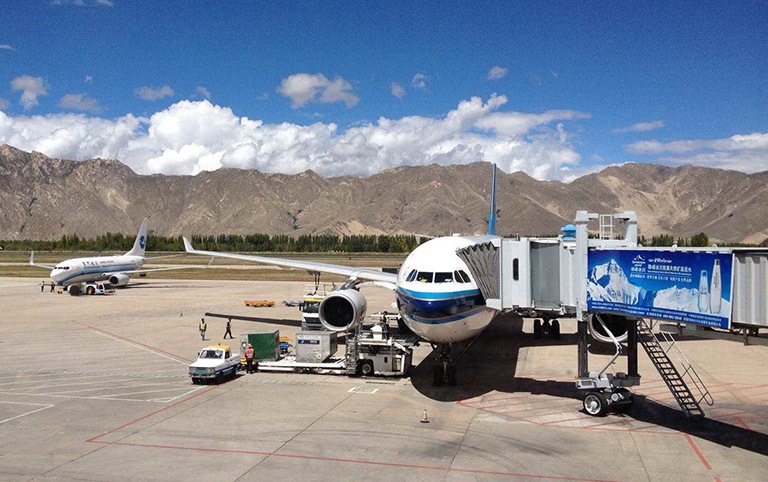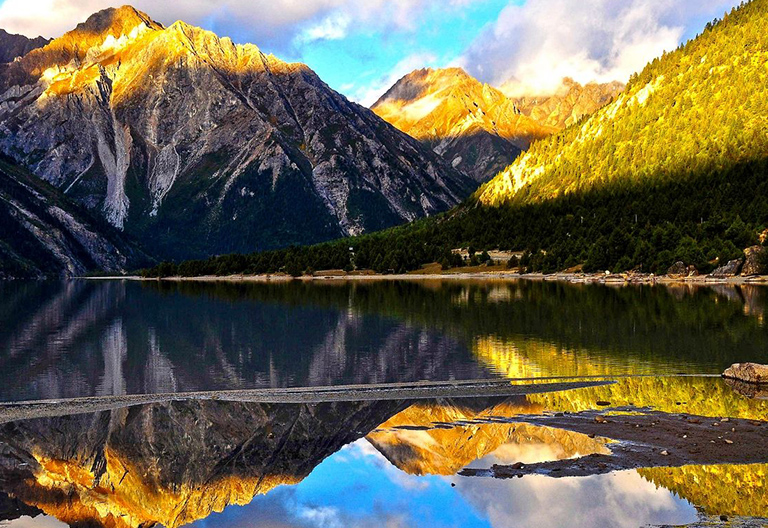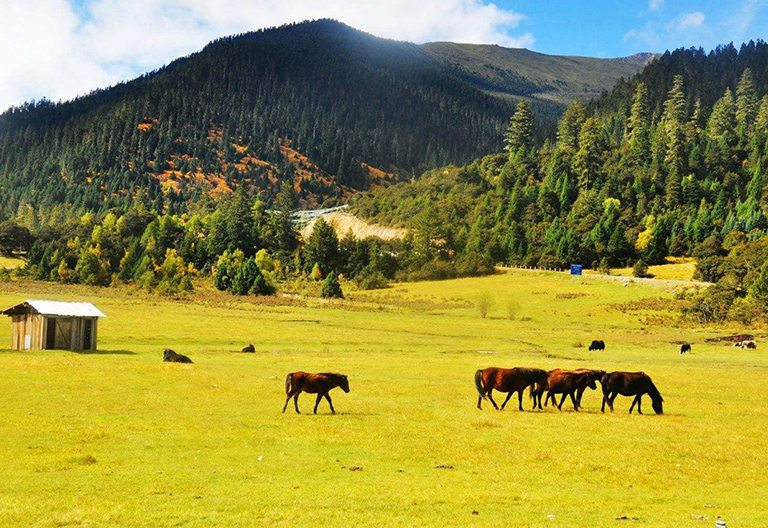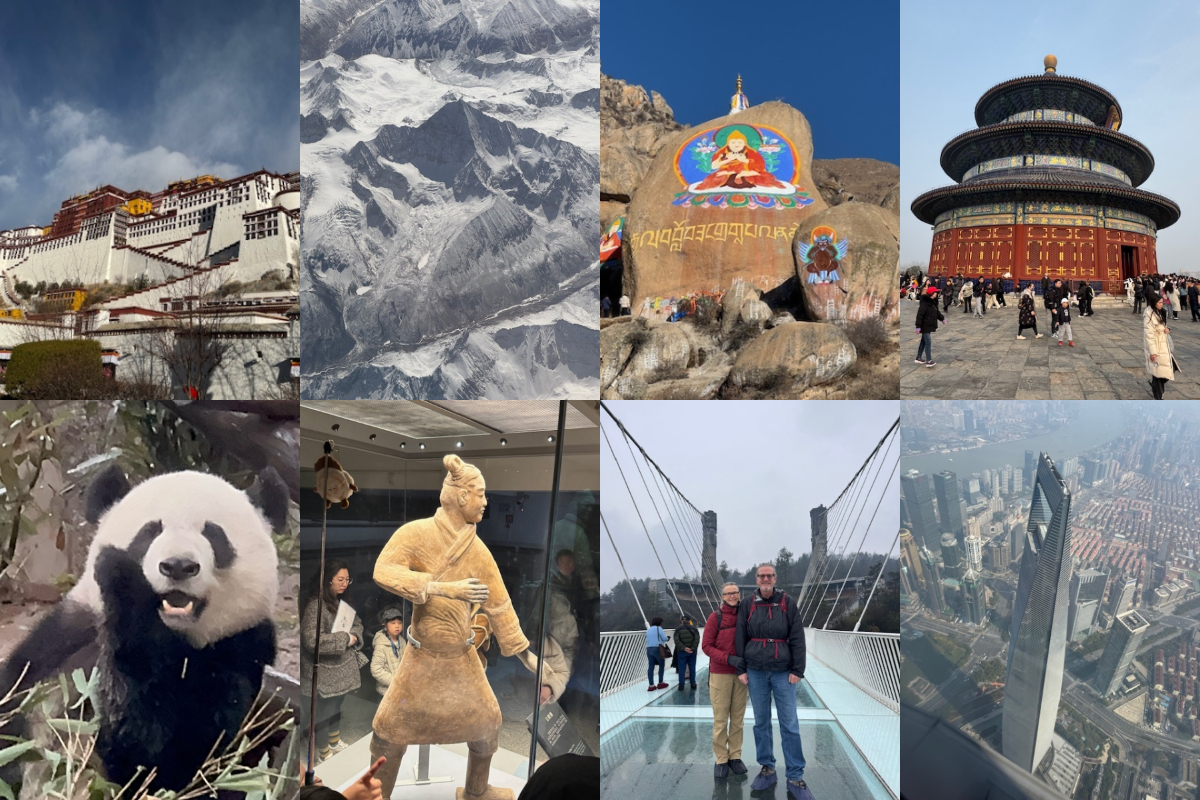This tour is strongly recommended for those interested in natural landscape, an incredible tour into the eastern part of the mysterious Tibet to experience the contradiction of harsh landscape in Lhasa and the Switzerland view in Nyingchi - snow mountains, wild forests, pure lakes, flowers... You will start your trip from Lhasa where you will spend 3 days visiting the Potala Palace, Jokhang Temple, Norbulingka Palace, etc., then drive to explore the stunning land Nyingchi.
Highlights of this tour:
- Climb up the grandiose Potala Palace and visit sacred Buddhist temples and monasteries in Lhasa, such as Jokhang Temple, Drepung Monastery;
- Drive along the most scenic highway in China - 318 to the "Switzerland in Tibet" - Nyingchi.
- Explore the fabulous Nyingchi landscapes - pure lakes surrounded by wild forests, giant glaciers, snow mountains, grasslands, villages, etc.
Tour Brief Information
- Tour price: from $962
- Tour code: TD-LNT-07
- Tour Type: Private Customizable Tour Package
- Destination: Lhasa / Nyingchi / Lhasa
- Duration: 7 days and 6 nights
- Departure: Flexible
- Travel Theme:




- Best Time:



- Physical Level
- Tour Pace
Leisure
- Max Altitude
5,013m
- Itinerary Details
- Included Services & Fees
- Reviews
- Gallery
- Make an Enquiry
Your tour - at a glance
Day 1 Lhasa Arrival
Day 2~3 Lhasa City Tour
Day 4~6 Lhasa - Nyingchi - Lhasa
Day 7 Lhasa Departure
Itinerary Details - Day by Day
Day 1 Lhasa Arrival
Lhasa Airport / Train Station Pick UpWelcome to the roof of the world! You will be picked up by local tour guide at Lhasa airport hall or train station, and then be escorted to check in your hotel in Lhasa city (3,650 m) in a private vehicle. The rest of the day is free for you to explore the local areas and acclimatize yourself to the air, temperature and high altitude of Lhasa.
High Altitude Acclimation Tips: 1) go for some leisure walking to acclimate the high altitude but avoid strenuous activity after arrival; 2) you'd better not have bath, in case of catching a cold; 3) drink more water, and have some fruit; 4) have a good rest...
How to Get to Lhasa: take a domestic flight from other cities like Chengdu, Beijing, Xian, Xining, Kunming, etc. or an international flight from Kathmandu, or take a train from China's other cities, like Chengdu, Xian, Beijing, Chongqing, Shanghai, Guangzhou, Xining, Lanzhou, etc.
-
 Lhasa Gonggar International Airport
Lhasa Gonggar International Airport
Day 2 Lhasa City Tour (B)
Today's Highlights: Norbulingka, Drepung Monastery, Sera MonasteryToday you will visit popular attractions in Lhasa city and suburb to explore Tibetan culture. You will firstly go to visit the beautiful Norbulingka which used to be the former summer palace of Dalai Lamas in the ancient time, and now is a public park. Dotted with various kinds of precious flowers and plants, it is the genuine "Plateau Oxygen Bar". In addition to its magnificent buildings and colorful flowers, Norbulingka also features some big Tibet event activities during big festivals, like Tibetan shows in annual Shoton Festival. Next, drive several kilometers to the western outskirts of Lhasa to visit Drepung Monastery. Drepung, in Tibetan, means "prosperity". Since its establishment, Drepung Monastery has always been one of the most important Buddhist monasteries in Tibet. In its heyday, there were more than 10,000 monks lived and studied in the monastery. Throughout its history, many important and famous Tibetan leaders used to study here, especially the Dalai Lamas. So Drepung Monastery is also respectfully known as the "Mother School of Dalai Lamas". You can also enjoy a panoramic view of Lhasa from Drepung Monastery.
In the afternoon, you will be taken to another famous monastery in Lhasa - Sera Monastery. It is famous for the spectacular "Buddhism Debating". As a daily routine, the monks gather in a courtyard, and debate on the Buddhist doctrines with supplemented gestures, which is thought to be helpful to facilitates better comprehension of the Buddhist philosophy to attain higher levels of study. After enjoying the "Buddhism Debating", you will be transferred back to the city. The rest time is your own free time to rest.
The Etiquette of Visiting Monastery: 1) you shouldn't wear short and uncover shoulders; 2) taking off your sunglasses and hat before entering the chapels; 3) taking photos is usually not allowed inside the chapels.
-
 Courtyard for Buddhism Debating in Sera Monastery
Courtyard for Buddhism Debating in Sera Monastery
-
 Monks Gathered at the Entrance of Drepung Monastery
Monks Gathered at the Entrance of Drepung Monastery
-
 Enjoy the bright flowers in Norblingka
Enjoy the bright flowers in Norblingka
Day 3 Lhasa Potala Palace Tour (B)
Today's Highlights: Potala Palace, Jokhang Temple, Barkhor StreetStart today's Lhasa exploration with an exciting visit to the landmark - Potala Palace which is the home to the successive Dalai Lama as well as a great masterpiece of Tibetan architecture. The whole palace is divided into the White Palace - living quarters and office to deal with political and Buddhist affairs for Dalai Lamas, and the Red Palace where houses several stupas of previous Dalai Lamas, many historical relics and precious arts. After entering the gate of Potala Palace, you need to walk up about 30 minutes along the zigzag stone paths with white-and-red walls to the White Palace. Remember to ascend the steps slowly and take some stops for sightseeing and rest which will be helpful to reduce high altitude sickness. Then explore the palace in an orderly way from the White Palace to the Red Palace, and exit from the back side. After Potala Palace visit, go to enjoy a leisure stroll in Zongjiao Lukang Park, a lovely park with pleasant scenery built around the lake behind Potala Palace. It is a great place to experience local Tibetans' living styles as you can see local people gathering and chatting, taking exercise, walking the kora, feeding wild birds and ducks, etc. If your day is clear, you can take some great photos of the reflection of Potala Palace on the lake in the park.
Continuing your exploration, you will then get to Jokhang Temple which is considered as the spiritual center of Lhasa and the most revered religious structure of Tibet. In front of Jokhang Temple, you can see crowds of pilgrims polishing the flagstones with their prostration, which is truly a heart-touching scene you will ever see. This temple is also known as the "house of Buddha" because it keeps the precious Jowo Rinpoche, the life-sized (5 foot/1.5m) image of the Shakyamuni at the age of 12. Rise to the top floor of this temple, you can see savor the beautiful golden roof and the view of Potala Palace afar. The last site for today’s exploration is the famous Barkhor Street. It is a circular and wide street encircling the Jokhang Temple. The local people like to walk on the street for several circles usually in the late afternoon as a daily tradition of pilgrimage. The street also has many shops selling a wide variety of traditional Tibetan goods, religious items and handcrafts.
Optional Activity: If your physical strength permits, take a short climb to the viewing-deck of Chakpori Hill to take a panoramic photo of Potala Palace after your Potala Palace visit.
Tips of today: 1) taking photos is not allowed inside the palace; 2) today you will be mainly outside, please bring some water, a hat, sun cream, and sun glasses with you.
-
 Potala Palace - Masterpiece of Tibetan Architecture
Potala Palace - Masterpiece of Tibetan Architecture
-
 Golden Roof of Jokhang Temple
Golden Roof of Jokhang Temple
-
 Barkhor Street
Barkhor Street
Day 4 Lhasa - Ganden Monastery - Bayi Town (B)
Today's Highlight: Ganden MonasteryToday, you are going to drive about 6 hours along the well-paved 318 National Road to Nyingchi, the Switzerland of Tibet. On route, you will take a side trip to Ganden Monastery - the first monastery of Gelug Sect of Tibetan Buddhism. It was founded in 1409 by the great master Tsongkhapa (1357-1419), which makes the monastery as one of the most important monasteries in Tibet. Ganden, in Tibetan, means "happiness and contentedness". So it is very meaningful to visit this temple. Ganden Monastery is also an architectural masterpiece with many features of traditional Tibetan-style monasteries. It made fully use of colors to create a sense of holiness and solemnity - white paths, red walls, black windows, golden roofs, yellow curtain. From the monastery, one can also enjoy a stunning panoramic view of surrounding mountains and valleys. Besides, there are a lot of infrequent cultural relics and handicrafts kept in the monastery.
After arrival at Bayi Town, you will be transferred to check in your hotel. The rest of today is free for you to explore this peaceful town.
Tips of Today: 1) wear warm clothes to prevent from cold and wild; 2) pack some food and drinks with you because you will spend much time on the road.
-
 Manuel's group from Spain visited beautiful Ganden Monastery
Manuel's group from Spain visited beautiful Ganden Monastery
Day 5 Bayi - Lulang (B)
Today's Highlights: King Cypress, Lulang ForestToday will be a pleasant full day of natural vision feast. Driving only about 1.5km out of the town, you will see the most famous and magical tree in Nyingchi area - the King Cypress which is about 50 meters tall and more than 2,500 years old. Leaving the King Cypress, you will move to the next attraction of today – Kading Valley. The highlight is a 200 meters high waterfall rushing out from a narrow valley between two mountains and dropping down rapidly. The most magic wonder is that a scene of Buddha is partly hidden and partly visible in the waterfall.
In the afternoon, you will explore the best highlight of today - Lulang Forest. It is a 15km long, 1km wide narrow valley of wild forests and flowers, grasslands and streams. Lulang, in Tibetan, means “Dragon Valley” or “the place where you won’t be homesick”. On the both sides of the valley are lofty green mountains covered by prosperous spruce, pine trees and brush. At the foot of the mountain are the beautiful meadows and villages. Winding streams flow through among the wooden houses. Wild flowers of different colors dot on the meadows. Look into distance over the valley are enormous snow-capped mountains. All these sceneries make Lulang a dream land.
Drive back to Bayi for accommodation.
-
 Charming Landscape of Lulang Forest in Nyingchi
Charming Landscape of Lulang Forest in Nyingchi
-
 Villages in Peaceful Lulang Forest
Villages in Peaceful Lulang Forest
-
 Richard and Hamad from USA visited Lulang Forest with Tibet Discovery
Richard and Hamad from USA visited Lulang Forest with Tibet Discovery
Day 6 Bayi - Basum-tso Lake - Lhasa (B)
Today's Highlight: Bamsum-tso LakeToday, we will drive back to Lhasa from Bayi Town. The whole journey will take about 7 hours, with a wonderful sidetrip to beautiful Basum-tso Lake.
The jade lake Basum-tso Lake is called as Cuogao Lake in Tibetan, meaning the green water. Surrounded by snow-capped peaks and natural forest, the lake is known for its primitive beauty and tranquility. Covering 26 square kilometers, the dark blue lake surface looks like a mirror, and clearly reflects the tall snow mountains and green plants in the lake, just like a picture. Besides, the lake is also a holy lake for Tibetan Buddhism Nyingma Sect. There are also a sacred Nyingma temple sited in a small island in the central lake for the pilgrims to worship to the Buddha, and a “magical hole” nearby the south shore for people to pray to the Buddha for a child. Combining beautiful scenery and amazing legends, Basum Lake is such a holy and spectacular place to explore!
Have a good rest in Lhasa City.
-
 The Path to the Central Island in Basum
The Path to the Central Island in Basum
-
 Beautiful Basum-tso Lake
Beautiful Basum-tso Lake
Day 7 Lhasa Departure (B)
Lhasa Airport or Train Station Dropped OffToday is free for you until your tour guide transfer you to the airport in time for your flight or drop you off at Lhasa train station.
Tips of today: 1) please pack your luggage carefully, especially for small things like camera charger, power adaptor, mobile phone, phone charger, wallet and towel; 2) if your flight is arranged in the afternoon, please make sure you check out the hotel before 12pm.
Useful Trip Notes
-
- 1. Tibet Permits Guaranteed
To travel in Tibet, all Non-Chinese passport holders need to have a Tibet Travel Permit which is issued by Tibet Tourism Bureau in Lhasa. And only Chinese travel agencies like Tibet Discovery can apply for the permit on behalf of tourists. You must obtain it before your tour starting because the permit will be checked when you board your flight/train to Tibet. Traveling with Tibet Discovery, you don't have to worry about the complicated procedures of Tibet Travel Permit application. All you have to do is to confirm a tour package with us and send us your passport and Chinese visa copies at least 15~20 days in advance before your tour, then we will take care of all the rest things. Once the permit is issued, we will deliver to your address in China, such as your hotel, local travel agency, etc.
-
- 2. Available Months to Visit Tibet
Generally speaking, April to October is the best time. July and August are the peak season and rainy season. It is usually snowy and cold in winter, which is not suitable for visit Mount Everest, Namtso and Mount Kailash regions. While other places such as Lhasa, Gyantse and Shigatse are suitable for travel all year around. The temperatures in daytime and night differs a lot, usually 5~15℃ in the daytime and -5~0℃ in the night, so please wear accordingly.
-
- 3. High Altitude Sickness
The average altitude of Tibet is about 4000 meters above the sea level (Lhasa: 3700m; EBC: 5200m; Namtso: 4718m). You may suffer a bit from High Altitude Sickness in the beginning days of your Tibet trip if you haven’t had rich high plateau travel experience. But don’t worry too much, the high altitude can be acclimatized usually in 2~3 days. Our suggestion is to take a physical examination and get suggestions from your doctor, and also bring some medicines to prevent from High Altitude Sickness before your trip. While in Tibet, you should keep warm all the time, avoid strenuous activities, drink more water and eat more vegetables and carbohydrates. You’d better not take showers during the first two days after your arrival in Tibet. If you don’t feel well, get help from your tour guide or go to the hospital without any delay.
-
- 4. How to Go to Tibet
Basically you have two options – flight and train. Currently, you can take a flight to Lhasa from Beijing(4.5hrs), Xian(3.7hrs), Chengdu(2.5hrs), Chongqing(3hrs), Kunming(3hrs), Kathmandu (1.5hrs), etc. Among all these cities, Chengdu and Xian have more frequent flights to Lhasa.
If you prefer a train travel, you can take a train to Tibet from Beijing(40.5hrs), Xian(32hrs), Chengdu(43hrs), Shanghai(47hrs), Chongqing(42hrs), Lanzhou(25hrs), Xining(22hrs), Guangzhou(54hrs). -
- 5. Packing and Wearing Ideas
Firstly you can’t forget your passport and Chinese Visa. A large backpack and a smaller one are recommended (the smaller one can be used for daily activities). Also bring necessary medicine you need. Other stuffs like sunglasses, snow glasses, hats, lip balm, sun block are recommended.
As for wearing, you are suggested to dress in layers (both thin and thick jackets). Down jacket is necessary in Spring and Autumn. A pair of durable and comfortable shoes is necessary.
Recommended Tibet Group Tour Packages
Escorted by a skilled driver and companied by a professional local tour guide to organize all the activities, all you have to do is to enjoy your fantastic Tibet journey.Following are some other recommended Tibet group tour packages that you may be interested in. You can also contact us to customize a trip if you want..
-

Bayi / Bomi / Ranwu / Bayi / Lhasa
8 Days Nyingchi Peach Blossom Festival Tour 2025
Highlights: Gala Peach Blossom Village, Ranwu Lake, Midui Glacier, Potala Palace
-

Bayi / Bomi / Rawo / Bayi / Lhasa
8 Days Tibet Dream Tour from Nyingchi to Lhasa
Highlights: Rawo Lake, Midui Glacier, Basum Tso Lake, Potala Palace
-

Lhasa / Nyingchi
7 Days Tibet "Switzerland Views" Tour (Lhasa - Nyingchi)
Highlights: Potala Palace, Basomtso Lake, Lulang Forest





 Karen
Karen Wonder
Wonder Jack
Jack Rita
Rita Johnson
Johnson Vivien
Vivien Wing
Wing Ariel
Ariel Leo
Leo Tracy
Tracy Evelyn
Evelyn April
April Phoebe
Phoebe Kelly
Kelly Shirley
Shirley Reya
Reya Juliet
Juliet Elk
Elk Felix
Felix Sean
Sean